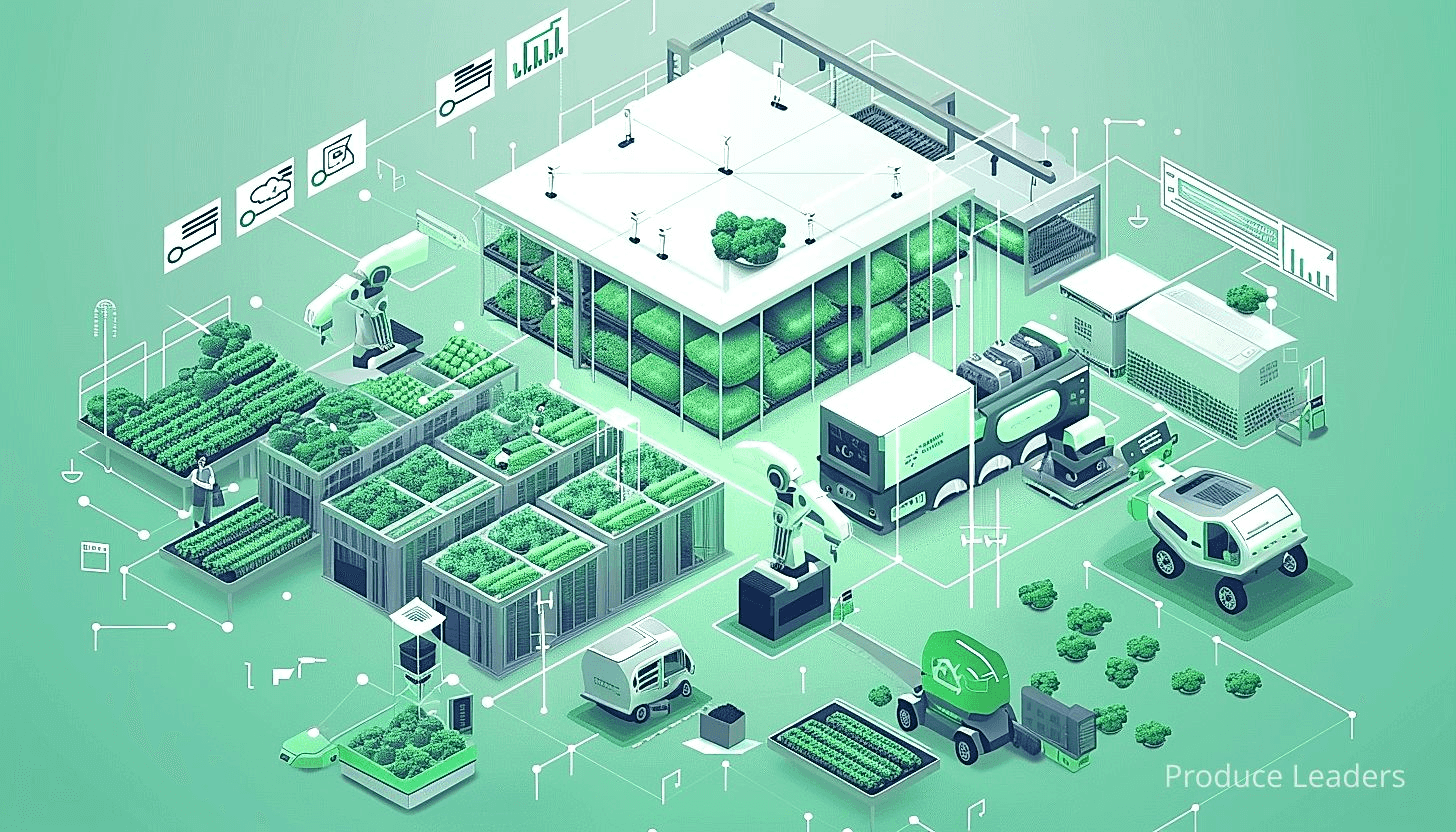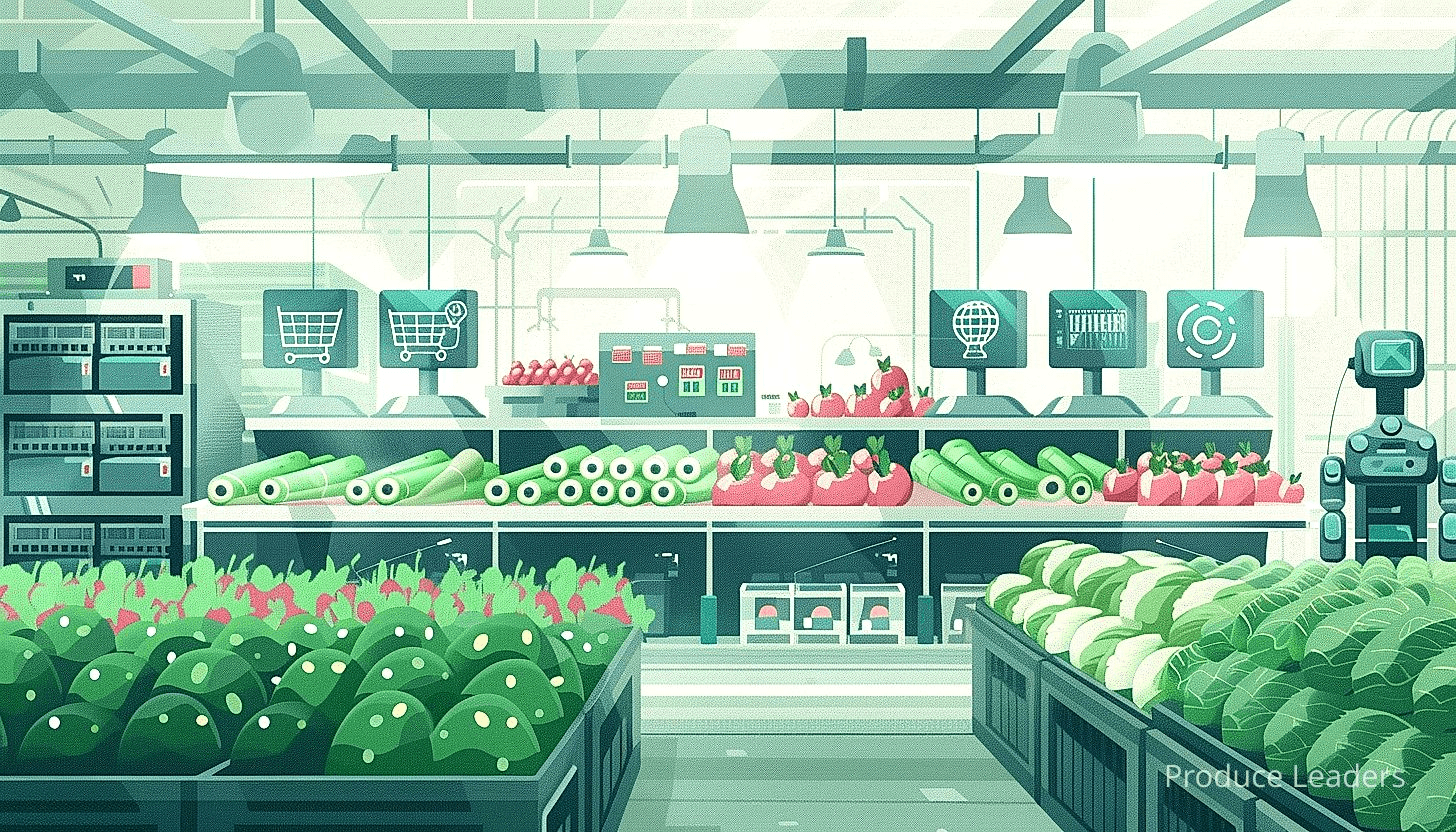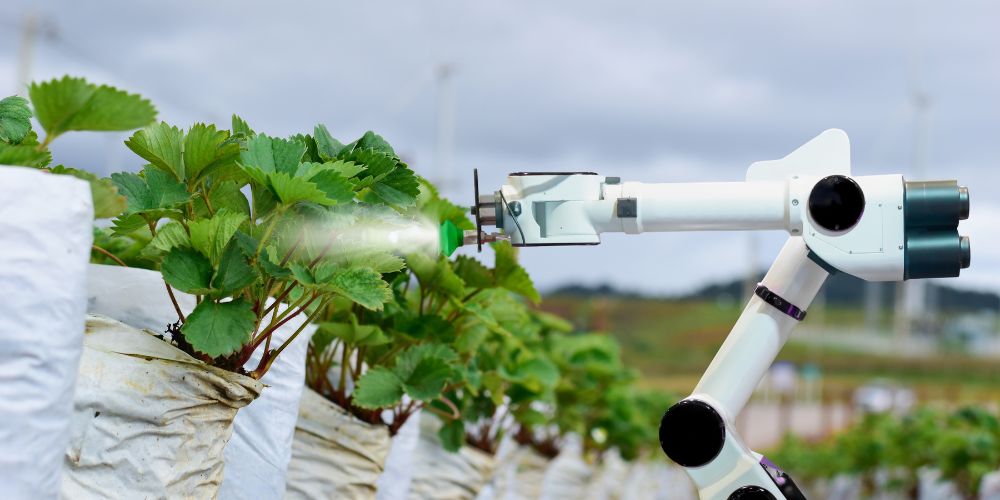Artificial Intelligence (AI) is transforming industries on a global scale.
One area witnessing significant advancements is the logistics sector, particularly in produce logistics.
The integration of AI can reign in a new era of efficiency and productivity.
Through predictive analytics, automated processes and advanced tracking systems, AI is ushering in much-needed innovation.
This revolution brings forth not only improvements in daily operations but also a considerable reduction in waste.
Examining these changes and the potential for further growth, it becomes evident how instrumental AI can be.
- AI enhances inventory management with predictive analytics.
- Optimized routes boost sustainability in logistics.
- Automated data collection significantly minimizes human errors.
- Demand forecasting, driven by AI, supports better planning.
- Quality control is improved via AI-enabled visual inspections.
While the aforementioned points highlight the efficiency of AI in produce logistics, there’s further value to uncover.
We’re going to explore other areas where AI can revolutionize how companies tackle logistical challenges.
You will gain insights into AI-powered quality checks, real-time tracking, and even reduction in food waste.
Contents
- Benefits Of Ai In Efficient Produce Logistics
- 1. Improved inventory management through predictive analytics
- 2. Enhanced Sustainability via Optimized Routes
- 3. Automated Data Collection Reduces Human Error
- 4. AI-driven demand forecasting for better planning
- 5. Improved Quality Control Through Visual Inspections
- 6. Real-time tracking for instant decision making
- 7. Increased Efficiency and Productivity in Operations
- The Bottom Line
Benefits Of Ai In Efficient Produce Logistics
1. Improved inventory management through predictive analytics
In Short: Artificial Intelligence enhances inventory management in produce logistics by utilizing predictive analytics for precise demand forecasting, reducing waste, increasing customer satisfaction, and lowering costs. Despite initial challenges, AI adoption in this field offers a strong competitive edge, transforming operations with its exceptional data handling and pattern-recognition capabilities.
Artificial Intelligence (AI) is proving to be a game-changer in the realm of inventory management in produce logistics.
Inventory management, a crucial part of managing the supply chain, benefits tremendously when propelled by the power of predictive analytics.
Being able to predict what will be needed, when, and in what quantity can significantly reduce waste and increase efficiency, both of which are important in the produce industry where freshness is paramount.
When this predictive power is harnessed by AI, the implications are transformative.
AI technology can analyze vast amounts of data at extraordinary speed, identifying patterns and trends far beyond the capacity of human analysts.
This analysis can forecast demand with precision, considering factors such as past usage trends, seasonality, and market changes.
This, in turn, allows for efficient inventory management, ensuring that there is neither an excess that leads to wastage nor shortages that lead to lost sales.
No doubt, predictive analytics birthed by AI can dramatically streamline operations and enhance efficiencies.
It’s also essential to list some of the tangible benefits that come with improved inventory management through predictive analysis:
- Improved Forecasting Accuracy: AI can parse through vast data sets and identify even subtle patterns, facilitating highly accurate demand forecasting.
- Decreased Waste: Accurate forecasts mean appropriate inventory levels, reducing the chance of valuable produce going to waste.
- Enhanced Customer Satisfaction: Having the right products in the right quantity at the right time results in happier customers.
- Lower Costs: AI-driven inventory management reduces storage and spoilage costs.
Artificial Intelligence technologies, machine learning algorithms in particular, provide an exceptional capacity to handle data dimensions, enabling detailed predictive analysis and robust inventory management.
The advent of AI and its predictive analytics capabilities represents a significant step forward for produce logistics.
However, as with any transformative technology, deploying AI for inventory management in produce logistics is not without its challenges.
Significant investments in technology and skills are required, and there might be resistance to change from within the organization.
But, these hurdles are trivial compared to the vast benefits that AI-driven predictive analytics can deliver.
As we continue to peel back the layers of AI’s potential in the industry, it’s clear that its power to enhance inventory management through predictive analytics offers a strong competitive edge in the ever-evolving world of produce logistics.
2. Enhanced Sustainability via Optimized Routes
In Short: AI advancements can enhance sustainability in produce logistics by optimizing delivery routes, minimizing carbon footprints and reducing CO2 emissions. Such AI-driven efficiency can enable businesses to contribute to combating climate change, improving their brand reputation, and bolstering operational effectiveness.
Within the realm of produce logistics, a significant challenge is the efficient planning of delivery routes.
The logistics field has always struggled with balancing efficient delivery and environmental sustainability.
However, recent advancements in AI offer promising solutions to this problem by providing enhanced route optimization solutions.

This allows businesses to minimize their carbon footprint, stay competitive in the market, and contribute to a more sustainable planet.
When executing routing plans, several factors such as traffic conditions, distance, fuel consumption, and vehicle load capacity play important roles.
Routing patterns that take note of these factors can facilitate timely delivery, reduced fuel usage, and as a result decreased carbon emissions.
This is where AI comes in – by processing large data sets of these factors, it can determine the most efficient delivery routes.
In this context, here are few ways AI enhance sustainability via optimized routes:
- Energy Efficiency: AI algorithms can optimize routes to favor roads and paths that consume less fuel. This not only reduces costs but also cuts emissions dramatically, resulting in more energy-efficient logistics operations.
- Reducing Road Traffic: By avoiding traffic congestion, AI can reduce the time that vehicles spend idling, thus lowering fuel consumption and emissions.
- Minimizing Distance Travelled: AI can also recommend the shortest and quickest routes, thus minimizing the distance travelled and the corresponding emissions.
Utilizing predictive analysis tools, AI can even predict future traffic patterns, weather conditions, and other obstacles to route planning.
The objective here is to proactively adjust scheduling and plan routes efficiently, minimizing any possible disruptions from unforeseen events.
With these factors being taken into consideration, AI-driven optimization of delivery routes can greatly increase the overall efficiency of logistics operations in the produce industry.
Moreover, the robustness and versatility of AI systems make them capable of handling multiple routing scenarios, providing solutions that are not only more efficient but also more adaptable to changing conditions.
At the same time, using AI for route optimization has the potential to drastically reduce CO2 emissions, leading to greater environmental sustainability in the long run.
By doing so, businesses can contribute to the fight against climate change, portray a positive image to consumers, improve their brand’s reputation and even comply with potential future regulations on carbon emissions.
Pro Tip: Optimize your delivery routes with AI to reduce your carbon footprint, improve operational efficiency, and enhance your brand’s sustainability reputation.
To summarize, the integration of AI in produce logistics can lead to more efficient and sustainable practices.
By choosing optimized routes for delivery, businesses can simultaneously reduce their environmental impact and enhance their operational efficiency.
3. Automated Data Collection Reduces Human Error
In Short: Automated data collection in logistics significantly reduces human error, enhances efficiency, and supports decision-making with accurate, real-time data. Consequently, it relieves staff from repetitive tasks, fostering creativity and innovation, and increasing operational productivity.
In the fast-paced, data-driven world of produce logistics, efficiency is everything. Automated data collection becomes the driving force that pushes logistics companies ahead of their competitors.
It’s often overlooked, but one of the main benefits of automation in logistics is its ability to significantly reduce human error.
This becomes increasingly crucial when you consider the negative impact mistakes have on both customer satisfaction and a company’s bottom line.
Errors within the logistics process can lead to costly delays and missteps, both of which can be avoided with automated data collection.
From inventory monitoring to shipping and receiving, automated data collection provides real-time, accurate, and reliable data.
This data can be leveraged to increase efficiency and streamline operations—benefits that translate into a more nimble and responsive logistics chain.
Now let’s outline some specific ways automation helps to minimize errors:
- Data accessibility: Automation makes large volumes of data readily available and easily accessible for analysis.
- Data consistency: Automated systems collect data in a uniform manner, ensuring a consistent level of quality.
- Real-time updates: Automated systems can provide instant updates, reducing the chances of outdated or incorrect data.
By utilizing automated data collection, logistics companies can ensure that the data they rely on to make important decisions is both accurate and up-to-date.
It’s also important to note that with automation in place, staff are relieved from tedious data entry tasks.
As a result, they can focus their efforts on more strategic, high-value tasks, leading to increased operational efficiency.
There’s also the added benefit of improved staff morale. Freed from the burden of repetitive tasks, staff can bring more creativity and innovation to their roles.
Not only will automated data collection cut down on errors and improve efficiency, but it also creates a more engaged and productive workforce.
When examining the benefits that automated data collection brings to produce logistics, it becomes clear that it goes beyond reducing error—it’s about optimizing every aspect of the logistics operation.
From better decision making to improved operational performance and worker satisfaction, automated data collection is a game-changer in the world of produce logistics.
4. AI-driven demand forecasting for better planning
In Short: AI’s capacity for accurate demand forecasting in produce logistics enhances inventory management and planning. This technology increases accuracy, anticipates seasonal variations, reduces waste and boosts overall operational efficiency, fostering a more sustainable and efficient business model.
The incorporation of artificial intelligence (AI) into various aspects of produce logistics has revolutionized the industry.
One game-changing application of AI is its capacity for accurate demand forecasting.
Demand forecasting is integral to inventory management, production planning, and understanding overall market trends.

Simply put, it helps a business prepare for the future.
Today, AI algorithms can study market trends, assess historical data, analyze sales patterns, and make precise predictions regarding future demand.
This ushers in a fundamentally improved approach to planning for logistical needs.
Let me tell you, how does AI improve demand forecasting for produce logistics?
Well, here are a few ways:
- Improved Accuracy: AI algorithms use complex computational procedures to handle a large amount of data. This enables them to predict demand with higher accuracy compared to manual methods.
- Anticipating Seasonal Variations: Produce goes through regular seasonal demand changes. AI can accurately predict these fluctuations, aiding in better strategic planning.
- Reduced Waste: In the produce industry, any overestimation of demand leads to waste. With AI’s precise demand predictions, this issue can be significantly mitigated.
- Increased Efficiency: AI-driven demand forecasting leads to optimized logistics management and operational efficiency.
The application of AI in demand forecasting in the logistics industry is not merely a technological novelty.
It addresses the very real problems of waste, inefficiency, and perhaps most importantly, sustainability issues which are currently a global concern.
AI-driven demand forecasting allows businesses to match their product offerings in line with market demands, reducing wastage and creating a more environmentally responsible supply chain.
As we move further into the digital age, the incorporation of solutions like AI will become not just a choice, but a necessity for businesses.
The advantages are much more than merely improving the bottom line; it also propels a business towards a sustainable, efficient, and future-ready operation.
Important: The application of artificial intelligence in demand forecasting dramatically improves accuracy, anticipates seasonal variations, reduces waste, and increases efficiency in logistics management, making this technology not merely a novelty, but a necessity for businesses striving for a sustainable and future-ready operation.
Even beyond just produce logistics, the influence and benefits of AI-driven demand forecasting are becoming evident in various fields of business and operations.
The future is here, and it promises to be more efficient and sustainable than ever before.
5. Improved Quality Control Through Visual Inspections
In Short: AI implementation in produce logistics has significantly enhanced quality control through visual inspections by automating defect detection, providing real-time monitoring, and increasing accuracy. This leads to higher standards of quality control, improved brand reputation, and increased customer satisfaction.
The implementation of artificial intelligence (AI) in produce logistics has produced a myriad of benefits, amongst which is a significant enhancement in quality control.
This advance has been largely due to the use of AI in conducting visual inspections.
Traditionally, visual inspections were carried out by human workers, an approach that, while effective to a degree, brought about several challenges.
The most notable among them being the impossibility of maintaining consistent accuracy over long periods due to fatigue and the inevitable subjectivity in human judgment.
AI, through the use of machine learning and computer vision, has effectively resolved these issues.
Through AI, it has become possible to conduct thorough and precise visual inspections of produce in real-time, thereby raising standards in quality control.
A few ways in which AI has revolutionized visual inspections in produce logistics include:
- Automated detection of defects and irregularities:
- Real-time monitoring of produce quality:
- Greater accuracy in spotting imperfections:
By automating the detection of defects, AI eliminates the likelihood of human oversight or error, thereby increasing the overall efficiency of the quality control process.
The introduction of real-time monitoring forsakes the need for intermittent checks, thus assuring consistent quality throughout the entire produce logistics chain.
AI’s precision in identifying even the smallest imperfections surpasses human abilities, leading to a more rigorous quality control process.
AI-based visual inspections are advantageous not only for the produce logistics chain but also for consumers. The higher standards of quality control lead to better and safer products.
Pro Tip: Implementing artificial intelligence in visual inspections can significantly enhance quality control in produce logistics by automating defect detection and real-time quality monitoring, leading to greater accuracy and efficiency.
Through the use of AI in visual inspections, producers and logistic providers can gain the trust of the market, enhance their brand reputation, and significantly boost customer satisfaction.
Thus, the role of visual inspections bolstered by artificial intelligence is paramount in achieving improved quality control in produce logistics.
6. Real-time tracking for instant decision making
In Short: AI-based real-time tracking significantly boosts efficiency in produce logistics by allowing for instantaneous decision-making, continuous monitoring of parameters like temperature and location, and proactive planning. This technology drives sustainable growth by improving operational efficiency, reducing waste, optimizing routes, and aiding in compliance with safety regulations.
Artificial intelligence (AI) has made it possible to track, in real-time, the many variables that affect produce logistics. This real-time tracking not only enhances transparency, but also allows for instant decision making that can greatly improve efficiency.
The dynamics of logistics for perishable goods like fruits and vegetables are complex and require a level of accuracy that is hard to achieve with traditional methods. A minor delay or temperature change can drastically degrade the quality of the produce leading to significant losses.
With AI-enabled real-time tracking, the location, temperature, humidity, and other essential parameters can be monitored continuously. This continuous monitoring allows for instant actions to be taken in case any of these parameters deviate from their optimal range. For instance, if the temperature in a cargo container rises above a certain level, quick action can be taken to restore it, preserving the quality of the produce.

Here are a few reasons why this instant decision making possible because of real-time tracking is crucial in produce logistics:
- Reduction in wastage: Quick actions can be taken to prevent spoilage of the produce, leading to significant reduction in wastage.
- Optimized routes: Given the real-time location data, routes can be optimized to ensure that the produce reaches its destination in the shortest possible time.
- Improved planning: Being aware of real-time stock and demand helps you plan better and avoid oversupply or undersupply situations.
- Compliance: Real-time data helps ensure compliance with food safety regulations, which is important in securing the trust of consumers and avoiding legal issues.
Additionally, real-time tracking offers better visibility into each stage of the logistics chain, from procurement to distribution. This transparency is essential in maintaining accountability and ensuring that best practices are followed throughout the process. It means that any party involved in the process can be held responsible for his actions and that no issue gets unnoticed or unaddressed.
Moreover, this kind of detailed, real-time visibility can become a powerful tool for managers. It can help them identify potential issues even before they arise, enabling them to manage risks effectively and make proactive decisions that save time, effort, and resources.
Furthermore, real-time tracking does not merely help in reactive decision making; it also facilitates proactive planning. By analyzing the patterns in the data captured over time, an AI system can predict future demands, possible disruptions, and suggest optimal strategies for various scenarios.
Important: AI-based real-time tracking can drastically improve efficiency in produce logistics by enabling instant decision-making, reducing wastage, optimizing routes, improving planning, ensuring compliance, and providing detailed visibility into each stage of the logistics chain.
This accessibility to real-time data and the ability of the AI system to make sense of it quickly enables a shift from a reactive approach to a more efficient, proactive approach. Therefore, allowing organizations to be more agile and responsive to changes.
Thus, by providing accurate and timely data and the ability for instant decision making, AI-based real-time tracking offers immense advantages to the world of produce logistics, improving operational efficiency, reducing waste, and ultimately driving sustainable growth.
7. Increased Efficiency and Productivity in Operations
In Short: Artificial Intelligence (AI) integration significantly enhances efficiency and productivity in the logistics sector by automating tasks, improving problem-solving and decision-making, and predicting demand for inventory management. AI systems also tackle operational disruptions such as traffic or weather delays through real-time tracking and instant notifications, paving the way for superior customer service and business growth.
The integration of Artificial Intelligence (AI) in produce logistics has significantly revamped the traditional ways of operation.
With AI, the overall efficiency and productivity in operations have observed a stupendous improvement.
The revolution brought about by AI is not only limited to replacing mundane manual tasks but extends to sophisticated strategies for predictive problem-solving and streamlined decision-making.
It’s noticeable how the AI-driven automation in logistics allows businesses to cope with increasing demand, ensuring goods are shipped seamlessly and rapidly.
AI integrated systems are designed to perform tasks rapidly, without error, and sometimes even without supervision with minimal downtime.
The inception of AI-based technologies such as machine learning, computer vision, and predictive analytics has played a significant role in enhancing operational efficiency.
These technologies help predict future demand, manage inventory, reduce human error, and undertake quality inspections.
This is undoubtedly a quantum leap from the traditional methods, which solely relied on human capabilities that can be prone to error.
There are several areas where AI is contributing to amplifying efficiency in logistics. Let’s dig in into a few of these below:
- Inventory Management: AI helps predict the demand and manage inventory, thus reducing the chances of overstocking or understocking.
- Quality Inspection: AI integrated systems enable high-quality visual inspections, facilitating the detection and resolution of issues, if any, at the earliest.
- Forecasting: AI plays a pivotal role in forecasting the demand, therefore giving a heads-up to the businesses for future stock preparation.
The logistics sector encounters numerous hurdles that can disrupt the flow of operations.
Issues like traffic conditions, weather updates, vehicle breakdowns, etc., often cause delays in delivering products or services.
However, AI tries to remedy these issues by providing real-time tracking, which enables the business to make immediate decisions and adjustments to the route.
Furthermore, the AI-integrated systems also give instant notifications to companies about any delays or obstacles that will affect the timing of delivery.
It’s evident how AI has thrived in bringing about an unprecedented evolution to the logistics industry.
Pro Tip: Implementing AI in your logistics operations can significantly boost efficiency, productivity, and quality control, making it a worthwhile investment for growth and expansion.
It reshapes the way the sector operates, leading to enhanced efficiency, reduced errors, and superior customer service.
While adapting to new-age technologies like AI may seem challenging, the benefits overpower the initial hurdle, making it a worthy investment for businesses aiming for growth and expansion.
The Bottom Line
Notwithstanding the complexity and challenges that come with AI, its usage in the agriculture industry, particularly in logistics, is proving to be a game-changer.
AI technology has demonstrated significant potential in enhancing efficiency in crop monitoring, predictive analytics, supply chain optimization, and in the decrease of food waste – important elements in the agriculture industry.
Through increased precision, greater control over all aspects of the process and by providing insightful data for decision-making, AI has ultimately led to improved profitability and sustainability in the agricultural sector.
Let me tell you, while AI might seem distant or inaccessible, its integration into the realm of produce logistics is gaining traction and the benefits – as seen, are rewarding.




















